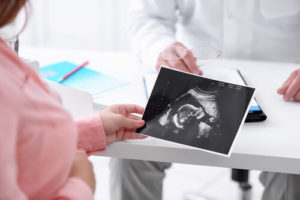Amniotic Fluid Disorders: Oligohydramnios

Oligohydramnios, like polyhydramnios, is an amniotic fluid disorder. Oligohydramnios involves the development of too little amniotic fluid rather than too much. Oligohydramnios occurs in approximately 8% of pregnancies.
If your amniotic fluid level is low, then a diagnosis of oligohydramnios may be indicated. If your child suffered injury due to an amniotic fluid disorder like oligohydramnios, please call Stern Law, PLLC (800) 462-5772 for a free consultation.
What are the signs and symptoms of oligohydramnios?
There are a number of signs and symptoms of oligohydramnios, such as:
- Your ultrasound demonstrates that your amniotic fluid depth level is 5 centimeters or less;
- Your water prematurely broke;
- You have not been gaining enough weight during your pregnancy;
- You have amniotic fluid leaking from your vagina;
- Your child’s heart rate is abnormal;
- Your child isn’t growing at the normal fetal rate;
What causes oligohydramnios?
As with polyhydramnios, there is no exact known cause of oligohydramnios. However, the following are associated as potential contributing factors to the condition:
- Birth defects that affect an unborn child’s central nervous and digestive systems;
- Maternal complications such as gestational or chronic diabetes, pre-eclampsia, dehydration, hypertension, and chronic hypoxia;
- Twin-twin transfusion. This occurs when one identical twin receives too much blood while the other twin receives too little;
- Post-term pregnancy;
- Premature rupture of membranes and/or leaking amniotic fluid;
What are the complications associated with oligohydramnios?
There are a number of complications associated with oligohydramnios, such as:
- Fetal organ compression resulting in potential birth defects;
- An increased chance of miscarriage or stillbirth;
- Intrauterine grown restriction;
- Preterm labor and birth;
- Labor related complications such as a compressed umbilical cord and meconium staining;
- Cesarean delivery;
How is oligohydramnios treated?
The treatment for oligohydramnios is contingent upon how far along you are in your pregnancy. If a woman is not yet at full term, a doctor will likely monitor her and her amniotic fluids for the remainder of her pregnancy. In addition, a doctor may also perform the following:
- Amnio-infusion during labor through the use of an intrauterine catheter – This involves the addition of fluid to a woman’s uterus that helps with cushioning the child and the umbilical cord in order to prevent complications from arising.
- Injection of an amniotic-type saline based fluid through an amniocentesis – In addition to amnio-infusion, this procedure may also be used to replace amniotic fluid to normal levels.
- Rehydration of a mother through IV/oral fluids – This helps increase low amniotic fluid levels in a mother suffering from dehydration, perhaps due to illness.
How are polyhydramnios and oligohydramnios diagnosed?
In addition to a fetal ultrasound, your doctor may also conduct additional tests for polyhydramnios or oligohydramnios, such as:
- Amniocentesis – This procedure involves collecting amniotic fluid through a syringe that is inserted into a pregnant woman’s abdomen and then subsequently tested for abnormalities.
- Glucose challenge test – This is a type of screening test used to determine whether a pregnant woman has gestational diabetes.
- Karyotype – This is also a screening test used to test for fetal chromosomal abnormalities. The cells required for testing can be obtained through an amniocentesis or chorionic villus sampling (a form of prenatal diagnostic testing involving the removal of tissue from the fetal sac in order to determine the existence of fetal abnormalities).
- Non-stress testing – A healthcare professional may conduct non-stress testing to monitor the well being of an unborn, post-term child. This test measures the child’s heart rate in response to his or her movements and may be repeated regularly should your doctor believe that your child has a condition that may cause fetal distress during delivery.
- Biophysical profile – This test combines a non-stress test with an ultrasound to examine whether a child is suffering from distress.
- Doppler flow studies – This involves the use of a special type of ultrasound that uses sound waves to measure fetal blood flow.
- Contraction stress test – This test checks how the child’s heart reacts to uterine contractions that arise during labor. Keep in mind that it is not typically performed in suspected cases of polyhydramnios due to the risk of preterm labor.
If your child suffered the aftermath of an undiagnosed or improperly treated amniotic fluid disorder, please call Stern Law, PLLC at (800) 462-5772 for a free consultation. Members of our team are ready to discuss your legal options.







